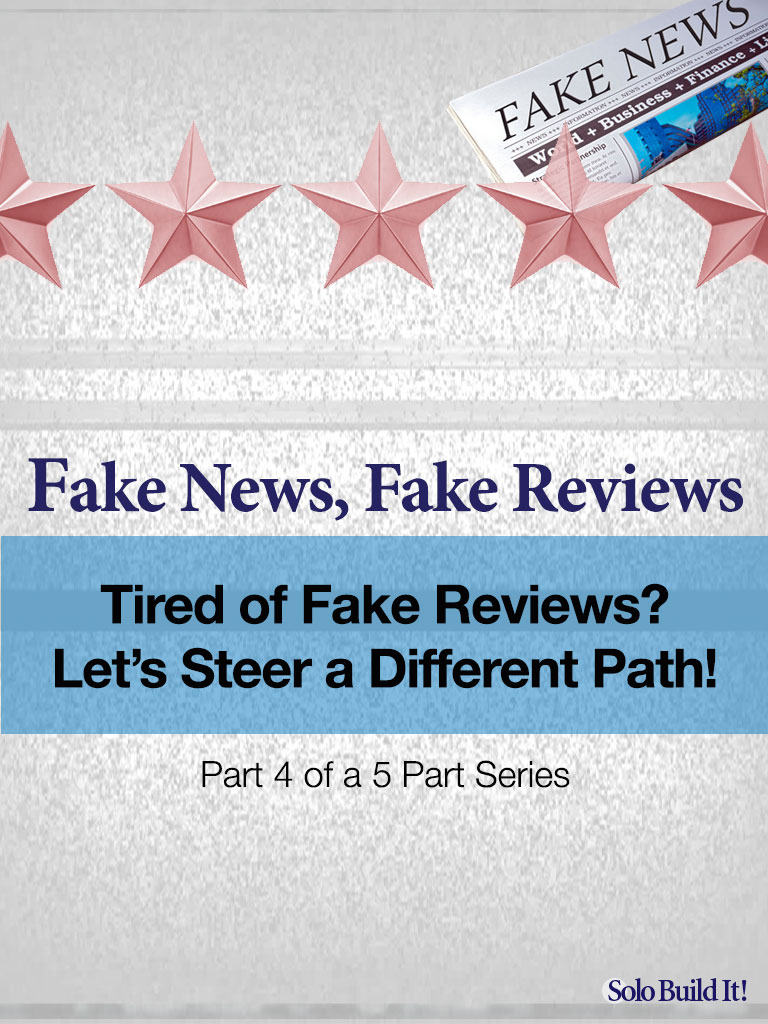
The 5 Parts: Fake Reviews
Part 1: What is a Fake Review, and Why Should You Care? (You are here)
Part 2: Peeling Away The Dark Side Of Internet Marketing
Part 3: Spot ’em and Stop ’em!
Part 4: Tired of Fake Reviews? Let’s Steer a Different Path!
Part 5: Beat the Fake – How to Gather Authentic Reviews for Your Business
 I have some startling news this week.
I have some startling news this week.
Tire companies lead the way in ethical reviews.
Say what? Tire companies??
Yep. Take a moment to read a section from an article in their recent online magazine (who knew there even was such a thing, right?!): “Tire Review” …
When customers entrust you with their automobiles, they have a presumption of full disclosure and honesty. So do this…
Have a shop meeting and pull up an extra chair. Tell your entire staff that the empty chair represents the spirit of your customer, and that everything that is discussed during the meeting should be able to be said in front of the customer without hesitation. Start the meeting by reinforcing your commitment to both ethics and customer service….
…You’ll have detailed records, your sales and profits will go up, and you will be doing the right things for the right reasons. If you follow this advice, and if you never put money ahead of people, you can’t lose.
“If you never put money ahead of people.”
Hold onto that thought.
In the first three articles of this series, we’ve looked at the depressing, scammy, often illegal world of fake reviews in the bigger world of online marketing. You’ve learned what fake reviews are, why they matter and how to both spot and stop them.
Today we’re coming out of the dark side into the light. Today, we’re going to look at how you can rise above the mire by making sure that affiliate reviews you write are honest, ethical — and nothing to do with fake.
But first…
Why Write Product Reviews?
Niched-based content pages form the foundation of most successful solopreneur-built online businesses. There’s no reason at all why some of that content cannot be product-focused.
There are two main reasons for the solopreneur to write product focused content pages:
- Authority: By reviewing products, and having people engage with them, you create more authority in your niche. You review products you know to be useful to your potential customers and it’s clear from your review that you know what you’re talking about.
- Money: We saw in “What Is a Fake Review, and Why Should You Care?” that reading reviews online is one of the final stages of the purchase path. Once a reader gets that far, she’s on the cusp of becoming a customer.
So product-focused content pages on your site can be especially profitable if you’re an affiliate of those products. You’re just one strong PREsell away from earning a commission.
Exciting, right? Right! But there are two big caveats to keep in mind…
- It’s easy to slip from PREselling mode to selling. As we’ve seen, some do that intentionally. We’ll assume that you, like most folks, are basically an honest person. But…
- With “commission” in the back of your mind, it’s all too human-nature-natural to “phrase to sell.” You subconsciously color a good feature a little too excitedly. You downplay negative features, or ignore them completely.
The final conclusion, a fair and objective one, helps the reader to make the best possible choice.
Helping the reader — your potential customer — should always be the main purpose of your reviews.
So What Exactly Is a Real Review?
In many ways it’s easier to turn that on its head and ask: “What is not a real review?” There’s plenty of information about that in the other articles in this series!
But the core answer is simple: It’s a review that helps the reader, who is likely on the edge of a purchase, to make the best choice possible.
A real review is not a sales page. It’s not written primarily to make money. Remember our friends in the world of tires:
“If you follow this advice, and if you never put money ahead of people, you can’t lose.”
It is, of course, fine to write direct sales page(s) when it comes time to sell your own products. That’s not what this article is about.
This article is about writing reviews of affiliate products that you’re promoting on your own site or blog.
A real review gives the reader the sense of deep knowledge and use of the product. The detailed content of the review provides evidence of that knowledge — something fake reviews can’t do.
Reviewers saying they know a product is not enough. We already know that creators of fake reviews lie. There should be enough evidence of knowledge that, if you were to ask a question about the product, you’d be confident of a straight, practical, down-to-earth reply.
Fake reviews often trash a product. Others spit out known facts and features. Whatever the approach, it’s “easy-to-do” content, created without having used the product. Ignore. Go for those with high quality content.
A real affiliate review is written as an honest, impartial opinion that reflects real experience. No remuneration (in any form) should be received by the author from the company that provides the product or service.
Which leads us to the question of the legalities of reviews. As an affiliate, you do not want to run afoul of the law. It’s unlikely that the police are ever going to knock on your door, but an ethical affiliate program should be contacting you if you cross the line.
So let’s get it correct, right off the bat. There’s no need to “fix” if you start right! (Many “fake reviewers” are going to be crying when “fake reviews” get hit by Google and/or the law).
What Do We Mean By an “Ethical” Review?
 The good news is that “legal” and “moral” are pretty much the same (a happy coincidence ).
The good news is that “legal” and “moral” are pretty much the same (a happy coincidence ).
A real review (whether of a product, service or business) can be positive, neutral or negative — the “verdict” doesn’t matter. But it should…
- be user-written — you have actually used the product or service, even if only to test it
- be your honest and impartial opinion
- be balanced and complete — not selecting only the positives, or only the negatives
- reflect a consumer’s genuine expectation — she has come to your review for a balanced opinion, not a sales funnel.
Disclosure
If you’re reviewing any product from which you stand to make a commission, no matter how small, you must self-identify as an affiliate. In other words, you must clearly state that you earn a commission if the reader clicks on your link and makes a purchase.
And, according to the Federal Trade Commission guidelines, that statement must be in a prominent location on the actual review page.
Putting a vague statement in your footer, or having an affiliate policy hidden somewhere on your site — or not having a statement at all — is not acceptable. Unsurprisingly, as we’ve seen, it’s what many companies that indulge in fake review practices often do.
The good news? In this cynical, murky world of fake news and fake reviews, honesty is a selling point. You will develop more trust, not less, by being transparent. Quite apart from it being against FTC guidelines, trying to hide your affiliate status is treating your visitors disrespectfully.
So make your affiliation a selling point. Be proud of what you’re PREselling — don’t try to hide the fact that you’ll make money from it, if they buy. If you’re delivering regular, high value content to your readers they won’t have a problem with you having the occasional affiliate link.
And if they do, perhaps they’re not a good fit for your business.
You have leeway in the language you use — so use it. Let’s face it. A statement such as this, while honest, is going to cast some doubt on your review…
How about this instead:
“I may earn a small amount from links to various products I recommend on this site. If you like what you’re reading, clicking on those links provides the funding that lets me do my passionate thing for home audio. Thanks very much.”
So make your affiliate statement with confidence. Stand proud with your integrity. Remember the world of tires…
“…never put money ahead of people.”
Put your trust in your site visitor. Allow her a fair chance to assess the review in the light of full disclosure. Because when you’re honest, and when a review is outstanding, such disclosure can be to your great advantage.
Are you really confident in your site visitors? Run a study of your own. Offer them a product with and without an affiliate link. Make clear which is which and what it means.
You might be as surprised at the results as Jonathan Fields was.
Should a Review Aim to Convince?
The short answer to that is “no.” And if you see an article titled: “How to Write Convincing Reviews” anywhere, beware. In those cases, “convincing” usually means “fake.”
One of Solo Build It!’s prime directives is: “Keep it real,” which is particularly relevant in this situation.
Reviews should not be “convincing.” They can and should be…
- complete, honest, balanced
- without agenda
- based on user experience
- authoritative, with your knowledge clearly shining through
- of true and honest value to the reader to help make the best decision possible.
But the one thing that a real review should not be is “convincing.” Your goal is not to convince anyone to purchase.
Product-focused content pages (reviews or other types of articles) can be valuable content, if they’re done right.
What Happens When It’s Not Possible to Use a Product?
Ideally, your review should include your personal experience of the product under review.
The FTC’s position is clear:
…the Endorsement Guides let endorsers know that they shouldn’t talk about their experience with a product if they haven’t tried it, or make claims about a product that would require proof they don’t have (1)
But what about when that’s not possible? After all, if you’re a travel site it’s unlikely you’ll be able to stay in all the best hotels in Venice! Or if you’re a gardening site, you probably won’t want to own 6 lawnmowers until you find the best!
The answer is to consider researching the best reviews and any other information you can find about the product. Then, pull that all together into your own original coverage of the product.
 This does not mean to take part of one review, then add part of another in a mish-mash of information.
This does not mean to take part of one review, then add part of another in a mish-mash of information.
It means doing some good quality secondary research. It will take time. But it can also provide you with a mass of high-quality information, which you then reduce to new content, with added thought, delivered in a format and voice that make it uniquely yours.
How?
- Sites like Amazon and TripAdvisor make it easy for you. Take all the reviews — positive and negative. What are the common complaints? What do people love? Who do the reviewers say the product is best suited to?
- What about videos? Are there reviews on YouTube? What do they say?
- Is it a branded product? What does the manufacturer say? What evidence do they provide? Video? User reviews?
- Can you do any testing in-store? What about talking to salespeople about their experience of it? (Be careful for bias here, too.)
- Suppose you’re reviewing a hi-fi speaker system. Turn a “lemon” (no hands-on) into lemonade with a video of you listening to various receivers in an AV room of a store, commenting on each as an assistant switches from one to another. Be sure to catch the sounds with your own mic…Visitors will hear all the sounds the same through computer speakers, but it still makes an impression that you’re testing them.
- How could you possibly do this? Ask! A local store may allow you to when the store is quiet in return for acknowledgment and a link. Get creative!
- As your site becomes more well-known, you’ll be able to get a sample for in-home testing. If it’s offered as a gift, of course, you must disclose that prominently on the website.
Again, it’s critical to be transparent.
Write a review that focuses on the site visitor (we’ll come to that in just a moment) and how you think it would benefit her. Make clear that it’s not based on personal use or experience but reflects accurate, exhaustive research of “expert” opinions. Detail what that means.
Add, of course, that it has been supplemented by your own conclusions based on all those hours of research.
It’s always better, though, to be able to build true user experience or hands-on testing into your review.
A “Review Site” or a “Site With Reviews” — Which is Best?
 Many review sites were hit hard during the time of Google’s Panda and Penguin algorithms — only a few did it right and sailed through. Others drifted into using reviews to sell, rather than treating them as the PREselling content that they should be.
Many review sites were hit hard during the time of Google’s Panda and Penguin algorithms — only a few did it right and sailed through. Others drifted into using reviews to sell, rather than treating them as the PREselling content that they should be.
Like I said, even honest folks can drift. It’s so darn easy to forget the point when you know you can earn something from a click.
The outcome was not pretty for many.
Great reviews generate sales without selling. So if you’re going to do a review site, do it well or go home.
Review quality is key, but originality, some sort of angle to help you stand out, will be what makes the difference, always assuming of course that you can write super reviews.
There will always be at least a couple of really big, strong competitors for your topic…
That’s normal.
If you think you can do better than half of the best 20 sites, if you see loads of reviews where a superior review will eventually put you into the Top 10, go for it.
The ability to use the product is important. You can “get away” with superb secondary research reviews in “Sites With Reviews.” But if you decide to work as a review specialist, it’s all the more critical.
Now… far be it from me to suggest that you buy a receiver, test it and take it back for a refund. And far be it from me to suggest going to a second store, trying another and refunding. Nor would I ever suggest a third and fourth, or neighboring towns, or anything else of that kind.
I would never suggest that! But heck…
 You really have to figure out the “get my hands-on testing done” problem. Later, you’ll have established yourself as “that cool site that does amazing reviews while dressed as a gorilla.” Companies will be happy to send you samples to test. But right now?
You really have to figure out the “get my hands-on testing done” problem. Later, you’ll have established yourself as “that cool site that does amazing reviews while dressed as a gorilla.” Companies will be happy to send you samples to test. But right now?
Unless your niche happens to have really weak reviews by people who haven’t used the product being reviewed, you really do need to have hands-on experience.
But it shouldn’t always be about reviews. Think outside the “normal” review sites and keep in mind SBI!’s emphasis on creating quality content.
How about information on the history of the product? Or doing interviews with key executives related to a product? Or asking others to submit reviews?
See? It’s now a “regular” content site. There are still loads of opportunities to include product reviews, but it’s become a “Site With Reviews,” not a “Review Site.”
Given the trust built up by the PREsell of all the other content, and the superiority of the reviews themselves, you’ll monetize even if the review pages themselves don’t win much search traffic.
This type of approach eliminates the “all or nothing” strategy of creating a “Review Site,” where every page, except your home page and maybe a couple of others, is a review. In other words, and this is important…
A “Site With Reviews” does not need the site to be found for reviews. That’s where a lot of the competition is duking it out — what used to be easy money ain’t so easy anymore. Instead, you get folks to your reviews via high value, high quality content!
What Does a “Best Practice” Review Look Like?
So we’ve looked at what makes a real review. But that’s not the end of the story.
That’s what you must do in order to be considered a real review, but it’s far from what you need to be the best.
 The closer you come to enabling the reader to almost feel, hear, touch or taste your product, the better!
The closer you come to enabling the reader to almost feel, hear, touch or taste your product, the better!
“Real” Is the minimum. We want to go for the max! And the “max” is always about OVERdelivery.
Your review must be several cuts above the typical reports that you can see in review aggregation services. Anything less than a high-value, genuine review should never reach your visitor’s eyes.
But in order to get there, you must first PREsell.
Want to write a lawnmower review? Shine with brilliance about lawns and mowing! Write great content about…
- Tips for watering your lawn the right way
- How not to scalp your grass
- When to mow — and when not to
- How to sharpen a lawnmower blade…
…and so on. Really show off your expertise, the knowledge you have about each piece of information. PREsell, until your customer thinks: “Whoa, this person really knows her stuff. I wonder which lawnmower she thinks is best for my uneven land…”
Bingo! That’s exactly what you want your visitor to think!
Written like this, you should stand out from competitor reviews, while attracting folks who are close-to-the purchase. You’ll be writing…
- reviews that readers will love
- reviews that won’t ever get hit by Google
- reviews that actually earn you more, in the long run.
Your tightly focused product pages will have an increasing chance of being found as your entire site grows its authority signals with Google. The hardest going, as always, is in the early months.
But by creating content that focuses on one specific product, and writing a highly personalized review, you gain a huge edge.
And Now for the Practicalities: How to Write a Real, Ethical Review
Focus on Your Audience
Let’s go back one final time to the world of tires…
It’s great advice!
Your site visitor, who is also your potential customer, should be at the forefront of every review you write.
So before you put pen to paper — or push a single key on your keyboard — pull up that virtual chair for your customer. Have her in front of you from start to finish. Heck — talk to her, if it helps!
You know this niche, you know your site visitor (you do know your site visitor, right?). Thinking about this particular product, ask yourself what her particular problem is and how this product will help solve it — how will it help improve her life? Why, specifically, would she buy this product?
Will she want to use it to…
- save time?
- save money?
- learn a specific lesson?
- feel a certain way?
- something else?
Once you can hone in on this — the 20% of a product that will convert 80% of people — you’ll be able to give your readers an honest review that also converts.
So let’s look at the substance of your review, all the time bearing in mind how your site visitor will genuinely benefit.
Introduction
The introduction is what draws people in, which is why it’s a good idea to start with a story. Perhaps share your own experience with the product, while at the same time reinforcing your commitment to ethics and customer service…
I only write reviews about products I genuinely know and love — I don’t receive any payment for this review.
I’ve written it because I’ve been using this lawnmower for several months now, and it makes my uneven lawn look like a bowling green. If it can do it for my lawn, it can do it for anyone’s!
But it does have its drawbacks and, because I genuinely care about you, my site visitor, I’ll be giving you the good, the bad and the ugly…
Writing the Main Content
Cover all the features you consider relevant: most products come with a lot of features. Instead of covering them all, keep that site visitor in mind and cover those that are most relevant, first.
What makes this product of interest to this potential customer? What are the benefits of the features you discuss?
Use the information you have about your niche and your visitors to address her main concerns. Is she worried about cost? Reliability? Delivery? The warranty, or customer support, or functionality of certain features?
Provide evidence: this is where physically owning a product or having experienced a service becomes invaluable.
 Make it a unique story, because otherwise you’re just repeating the same dull information your visitors already read on Amazon and other product review sites.
Make it a unique story, because otherwise you’re just repeating the same dull information your visitors already read on Amazon and other product review sites.
They haven’t come to your site to read that same stuff… they’ve come for a unique perspective they can’t find anywhere else.
Remember, you’re writing about a very tight topic. Every competitor who’s half-decent will cover the basics well. You must do that better — and go well beyond.
We’ve covered the issue of products you haven’t tried, or services you haven’t experienced. But it’s right to say that you don’t “obtain” original research — you do it. The end result is content that’s truly authentic and reflects the clear voice of first-hand experience.
Visitors respect that enormously — this type of review has high value. So, wherever possible, get your hands on the product. Spend a few hours playing with it — even doing your best to break it!
That simple experience allows you to create content easily, simply by writing about what you see and do. You’re able to write a review that overdelivers — doing it in your own words, your own way, in your own voice, leaving readers with a strong “got it” feeling.
Include negatives: It’s a myth to think that people won’t buy a product that has negative reviews — in fact, the very reverse is true. Evidence is that people using reviews actively search for the negatives. In and of themselves, they help establish brand credibility and trust.
Why?
Because as John McAteer, Google’s retail industry director said:
No one trusts all positive reviews.
While brands and retailers should strive for a sizable majority of positive reviews, consumers view the absence of negative reviews as suspicious. So if the product you’re reviewing has drawbacks, be honest. Say what they are.
Remember: honest opinion of value to the reader. Not sales funnel.
Images and video: these give you the opportunity to add unique elements to your written content, because most sites borrow heavily from copy and photos supplied to them by manufacturers.
There’s no originality. That’s a formula for failure, not to mention that Google tends not to rank “transaction pages” highly.
So take some high quality photos of your product. Show parts that other reviews don’t. Include yourself in some of them — they’re further evidence of your use of the product.
And while you’re unpacking and user-testing the product, make videos, too. YouTube reviews do well. Add short snippets to your website review, and the longer video review on YouTube. The snippets also make great social media content.
How about presenting an infographic of your information? Free tools such as Canva can help make striking, easily understandable summaries that work well on social media sites.
Heck, I’m getting excited about this — you’re going to create some standout content!
The Summary
At the end of your review, consider adding a “Summary” box. Include the most critical factors that you consider the most relevant to your site visitor.
And how about creating your own “stars” system? Make it original to your niche, if you can.
- Is your niche gardening? A lawnmower icon should make the cut!

- Homesteading niche? Look for golden eggs to score those book reviews!

- Comparing the best beaches in Anguilla? Get palm trees for that relaxed vibe!

You get the picture. Take the idea. Make it your own.
Questions
And finally: we’re not quite finished yet! Because… questions! Encourage them. Add commenting to your review so people can have their say. It’s a good way of determining whether your product is a roaring success.
Enter into discussion. If they don’t like the product, ask which other they prefer, and why.
When you’re asked questions, answer promptly and honestly. It’s one more way of providing the proof that fake reviews don’t have. Proof that you have used the product and know what its capabilities are.
The people who write most fake reviews can’t answer detailed questions — because they’ve never tried the product.
And now — you’re done. Phew! Look over your review. What have you missed? What tiny detail will make it instantly a “Wow!” with your readers?
Let it settle in your mind for a while. Review it once more. And then — publish, safe in the knowledge that you have written a high quality, ethical article which will above all help your site visitor with whatever problem or desire it was that led them to you in the first place.
Let’s Sum Up…
This has been a long, sometimes hard series of articles to write — and to read. It’s taken us from the quagmire depths of the spammiest, scammiest fake reviews to the soaring heights of writing your own honest, professional product articles.
 It’s had its lighter moments, too, going from Roman coins to tire customers by way of banana slicers and the chocolate diet.
It’s had its lighter moments, too, going from Roman coins to tire customers by way of banana slicers and the chocolate diet.
We’ve seen that there are ways to fight fake reviews. In Article 3 of this series, “Spot ’em and Stop ’em,” we considered legal and technological pathways, together with the need to look for specific proof and direct evidence.
We looked at the way in which our own company has fought back against a sustained campaign of fake reviews by drowning out the scammy fake with real, honest, from-the-heart reviews by people who know, love — and use — our platform to grow their own successful businesses.
And finally, in this article we’ve reviewed the personal and professional responsibility each of us has for maintaining our own honor and integrity in the way we write reviews.
The most important take-aways?
- Learn to recognize the enormity of the issue of fake reviews and their effects on both companies and the individual consumer.
- Remember that “bait-and-switch” reviews in particular are wolves in sheeps’ clothing: “under the guise of helping, they hurt.” By recommending inferior products over those with proven accomplishment, they rob individuals of life opportunities, dreams — and success.
- Always insist on evidence — verifiable proof of success.
- Learn to spot fakery when it happens, and take action.
- Don’t stuff your own sales text down people’s throats. Keep it real. PREsell. Build trust with high quality content that targets your readers’ needs and wants.
And — very finally — remember tires. Remember always to concentrate on doing right by your visitor. Remember that…
“If you follow this advice, and if you never put money ahead of people, you can’t lose.”
The 5 Parts: Fake Reviews
Part 1: What is a Fake Review, and Why Should You Care? (You are here)
Part 2: Peeling Away The Dark Side Of Internet Marketing
Part 3: Spot ’em and Stop ’em!
Part 4: Tired of Fake Reviews? Let’s Steer a Different Path!
Part 5: Beat the Fake – How to Gather Authentic Reviews for Your Business
Sign up below to receive more great articles like this to you inbox!



